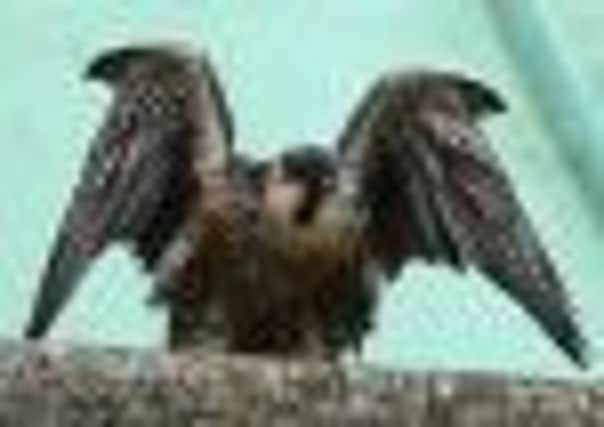Chichester's peregrines are the city's high flyers


Whether they like it or not, their decade in residence at the cathedral has gained them celebrity status that has spawned an impressive array of merchandising, backed by webcam updates that have made them stars of the internet.
As the RSPB’s latest summer awareness campaign draws to a conclusion in the grounds of the cathedral, it seems the nesting pair’s latest brood of several chicks appears in an exceptionally rude vein of health.
Advertisement
Hide AdAdvertisement
Hide AdThat was sadly not always the case for this remarkable species of bird, which had faced near-extinction in the 1940s and 1950s due to the use of toxic chemicals such as DDT in farming. They had also been extremely affected during the wartime years as they were treated as pests for taking military carrier pigeons.


But over the past two decades, they’ve slowly started to make a return, branching out from their traditional coastal areas including the Western shores of our country, often exchanging rugged cliff tops for tall city buildings.
With no shortage of birdlife prey around in the form of pigeons and other smaller birds, Chichester’s much-admired feathered family have found urban life is very much to their liking.
While they may not be universally loved for their dietary habits, it’s clear the vast majority of residents and visitors to the city are extremely approving of their presence.
Advertisement
Hide AdAdvertisement
Hide AdIf any evidence of this were needed, you would just need to take a quick trip down West Street in Chichester and spot how many people are glancing skywards to check up on them.


For the last few years, the RSPB has built on the work originally set up by the Sussex Ornithological Society (which first put a nesting box on the cathedral more than a decade ago), with its annual project offering people the chance to view the nest from its cathedral stall.
Being particularly close to the scheme, Mark Weston, who is an events manager with the RSPB, revealed there had been an excellent response from the public to its work.
He said: “They are important as they have been reported as being the most successful breeding pair of peregrines in the UK . They have now had 44 eggs, 42 of which have hatched with the birds.
Advertisement
Hide AdAdvertisement
Hide Ad“They are great at looking after and protecting their young – which we saw the other week when one of the birds knocked a buzzard out of the sky which had been getting too close to their nest – it’s now recovering at Brent Lodge.”
The manager explained this summer’s stall had proved particularly popular with visitors, with a number of people returning on a daily basis just to find out exactly how the peregrine family is doing.
He says they’ve resisted giving them names as they did not wish to trivialise their emergence in the area, which he felt had meant a great deal to many people living in the city.
“They are pretty amazing birds and it is just wonderful to see them here. It is great we can show them to young children as well, because it’s always much more fun to learn about things close up,” he added of the birds, whose territory spans throughout the district, including the female’s established additional winter territory in Pagham Harbour – which is now under RSPB management.
Advertisement
Hide AdAdvertisement
Hide AdAccording to Mark, the pressures on coastal environments that would traditionally have been their home mean there is now a growing trend of young peregrines seeking out alternative nesting sites such as cathedrals and tall city buildings.
Kay McLusky, of Chichester Cathedral Shop, felt its winged stars had captured the public’s imagination.
She said: “The peregrines do draw customers to us, which is a good thing.
“One of our best assets as a store is that we are quite different from the high street and have been running the merchandising for the peregrines for the last four years now and they have been bestsellers. It really does give us a boost having them here.”
Advertisement
Hide AdAdvertisement
Hide AdClearly, they are widely appreciated: as Graham Roberts of the Sussex Ornithological Society reveals, more than 35,000 visitors were recorded last year to see the peregrines.
Having monitored their presence since the first sighting in the mid 90s, he said it has been rewarding to see their progress since he was involved in installing the original nest box.
Highly skilled at his work, he is responsible for ringing each year’s brood of chicks, so their movements can be tracked.
He said: “When I first saw a male peregrine there in the 90s, I thought it could be a big spectacle for the public if we were to have them here more permanently, rather than places you might expect to see them such as South Wales.
Advertisement
Hide AdAdvertisement
Hide Ad“We’ve worked with the RSPB on this to manage the project and they have hundreds of volunteers who are able to assist. It’s great to have the peregrines, they are the top predator, top of the food chain and are quite an icon, having almost died out in the 1940s and 1950s.
“For me, it’s about getting across the message of wildlife conservation to people who don’t normally get involved.”
As he explained, it takes some training to be able to carefully tag each chick, but it has meant the society has traced them across the county and far further afield.